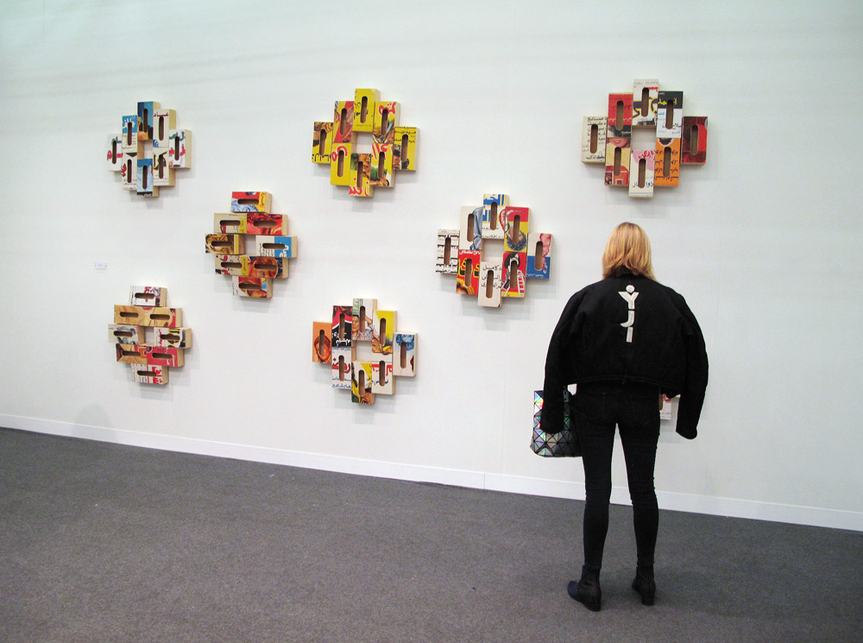
R
E
V N
E
X
T
Asian Artists and Galleries at the 2016 Armory Show
Earlier this month, the Armory Show returned to Piers 92 and 94 on New York City’s Hudson River for the 22nd edition of the international art fair, with 205 exhibitors from 36 countries—yet there were fewer Asian galleries than in any recent year.
In 2014, when the Armory Focus (a section of the fair that highlights artists from a specific region, which differs each year) was China, there were 25 Asian galleries at the fair. The following year, when the Focus was the Middle East, North Africa and the Mediterranean, there were 20 Asian galleries. This year, with the Focus being African Perspectives, the number of participating galleries from Asia is down to just 10.
Back for a third time exhibiting at the fair, Jeddah-based Athr Gallery brought three Arab conceptual artists from the Middle East—Hazem Harb, Ayman Yossri Daydban and Nasser al-Salem—and a multidisciplinary artist from the Philippines, Poklong Anading, whose photographic work had been featured in the 2013 Guggenheim Museum exhibition “No Country: Contemporary Art for South and Southeast Asia.”
Ayman Yossri Daydban, however, was the standout at Athr’s booth at the Armory. A Palestinian artist who has lived his whole life in Saudi Arabia, Dayban exhibited eight abstract flowers, made from wooden tissue boxes covered with fragments of Egyptian movie posters from the 1970s, on the large back wall of the booth. Referencing Adel Imam, a revered Egyptian movie star, the work metaphorically relates the tears that have been shed over films of the past to the current political turmoil that has left Egypt longing for a return to older—and better—times.
Tokyo’s Ota Fine Arts presented a two-person show of female artists, painter Tomoko Kashiki of Japan and Yeesookyung, a celebrated Korean artist who is best known for her sculptures made from broken ceramic vessels that are surreally re-assembled at the joints with epoxy and 24-karat gold-leaf. The gallery exhibited one of Yeesookyung’s largest works of this kind—a vase-shaped accumulation of teapots with little ornamental animals peppered throughout the massive piece—along with a large-scale work of cinnabar on paper, featuring animals, witches and fairies surrounded by flames. Yeesookyung’s works were smartly paired with paintings and drawings of delicately rendered, whimsical narratives by the talented Kashiki, who is also inspired by fairy tales and myths.
Revisionist works dominated many of the galleries, with Whitestone Gallery (Tokyo and Hong Kong) and Axel Vervoordt Gallery (Antwerp and Hong Kong) presenting the powerful works of the postwar Japanese art group Gutai, and Gana Art (Seoul and Busan) and the combined booths of Kukje/Tina Kim Gallery (Seoul and New York) showcasing masterpieces of Dansaekhwa, a Korean monochrome painting movement active during the 1970s. Whitestone had two, expressive 1962 paintings by Kazuo Shiraga, who famously painted with his feet, while Vervoordt had a similarly sized gem from 1963 by the artist, prominently occupying the center wall of its booth.
Three strong solo shows somewhat made up for the lack of Asian galleries at the fair. Beijing’s INK Studio offered new paintings by San Francisco- and Shanghai-based artist Zheng Chongbin, whose large-scale abstract paintings are made using a mix of ink with paint to simulate natural land formations. Tel Aviv’s Hezi Cohen Gallery showed a dynamic display of sculptures, photographs and videos by Israeli artist Sigalit Landau that represented her engagement with the salt-crystallization of objects immersed in the Dead Sea. Lastly, Pi Artworks (Istanbul and London) brought work by German-Egyptian artist Susan Hefuna back to the Armory Show for a second consecutive year, with a larger booth exhibiting her non-representational drawings, textiles and sculptures of abstracted urban sites.
Work by the Japanese contemporary artist Yoshitomo Nara popped up at a couple of booths, but overall the fair did little to represent the influence of Asian artists in the global art world today. However, next year may be better. With the recent appointment of former Artnet News’ editor-in-chief Benjamin Genocchio (an Australian-born, New York-based expert in Asian contemporary art) as the new executive director of the Armory Show, the future of the fair is looking a bit brighter.



